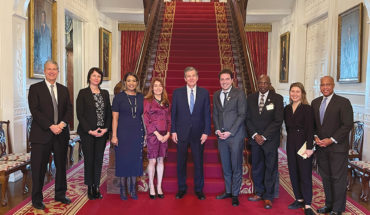by Tina Haver Currin
photographs by Keith Isaacs
The zigzag of Capital Boulevard as it wends its way into downtown is often crowded, sometimes bumpy, and never particularly pleasant. But if you exit to the right just as Capital becomes Dawson Street, you enter a different world. There, behind brick walls and large wooden gates, is a retreat of swaying palm trees, crystal blue reflecting waters, and tufts of sweet jasmine curling their way up toward a terra cotta-tiled roof. It’s completely removed from the hustle and bustle of Raleigh’s main artery, and everyone is invited. But this oasis didn’t appear by magic. It’s the result of the vision, patience, and significant investment of one Raleigh man.
“The whole design concept is that you are in somebody’s house,” says Samad Hachby, the owner of the pools and palms. He operates his Moroccan-influenced restaurant, Babylon, in the ground floor of the historic mill that anchors the space. “If you go to a house in Morocco, you have an interior courtyard for maximum light. You have water, you have food, you have booze, and it’s beautiful. But this place was a dump with no parking lot.”

The courtyard has all the elements of a house in Morocco according to owner Samad Hachby – water, food, and drink – and anchors the historic Melrose Knitting Mill.
Hachby, 44, left Casablanca for a stint aboard a cruise ship before relocating to North Carolina to attend N.C. State in 1998. He first noticed the 116-year-old brick Melrose Knitting Mill in 2004, before he opened Mosaic, a wine lounge perched on the corner of Jones Street and Glenwood Avenue. The knitting mill’s landlord, Abdul G. Zalal – or, as his friends call him, A.G. – was holding the building for a prospective tenant who wanted to turn it into a gym.
“I kept walking by, and nothing was happening,” Hachby says. “So, one day (in 2009), I walked in and I said, ‘A.G., I am going to do this project.’ He said ‘OK,’ and we shook hands.”
The mill had sat empty for years, and Hachby spent the next two and a half years making it restaurant-ready. That involved significant interior renovations, including replacing ancient wiring and plumbing. Hachby also made several trips to Casablanca to find the fittings he needed to create the place he envisioned.
“I wanted a classic palatial ceiling that you’d find in Europe, southern Spain, or Morocco,” Hachby says, craning his neck to admire the handiwork. His dark hair and the faint beard are the same color as the espresso he sips to ward off an afternoon slump.
“I went to Casablanca to find artisans who do work in Malaysia and Dubai. Forty men worked for two months on the tiles. They sent each piece separately – without instructions, of course.”
By the summer of 2011 he was ready to open Babylon’s doors. It has since become a popular and cozy cavern for dining on braised lamb tagine or crispy margherita pizza. For four years, Hachby himself was at the helm of the kitchen. His goal was to create a menu to reflect the restaurant’s unique atmosphere, with Moroccan classics like hearty harira soup made from lentils and chickpeas, couscous topped with meats and vegetables, and tasting plates overflowing with hummus, eggplant, and marinated olives. Last year, Chef Jean Paul Fontaine stepped in as executive chef. He developed the menu for Babylon’s new outdoor kitchen and a satellite kitchen in a recently renovated upstairs event space.
With plush, high-backed seating, a well-appointed bar and roughly hewn exposed beams, Babylon’s main room provides a rustic retreat. An adjacent room often used for parties features high ceilings with classic Moorish tiles and chandeliers that sparkle in the midday sunlight, while in a tucked-away library room, beams from the original factory hold cookbooks and magazines. Four hundred square feet of beige travertine marble cover the floors, blending with the brick walls.
Hachby and his team had to lay each piece on the floor, like a jigsaw puzzle, and then mount the tiles on the ceiling one at a time from the center, radiating out. Hachby points to sections of brick where his crew – or previous crews before him – began construction, only to realize that continuing would compromise the structure or historical integrity of the mill. The building’s walls tell a story of half-starts in holes and patches.
One floor above the tiled ceiling, the restoration of a massive events space, which hosted the Raleigh Food and Wine Festival in May, is finally complete. Hachby installed a second kitchen with direct access to the space, so his staff doesn’t have to clamber up and down the stairs from Babylon with piles of dirty dishes. Gorgeous rounded windows bathe exposed brick and wood in warm, natural light. Adjacent to the events space, a new tenant in Furbish Studio brings even more style to the historic mill.
Textile roots
Though the Melrose is now one of Raleigh’s loveliest treasures, it has been a long time in the making. The groundbreaking for the textile mill occurred in June of 1900, and the building was completed by October. The mill officially began manufacturing men’s wool and cotton underwear on January 28, 1901. Three years later, 85 employees – many of whom lived in small wooden homes around the property – were turning out 1,800 pieces of underwear a day.
That same year, the Pullen Park Pool – the city’s first – brought an increased interest in swimming to the community, so bathing suits were added to the Melrose repertoire. The City of Raleigh ordered five dozen suits from the factory, which patrons could rent for five cents per visit.
But the operations of the Melrose were short-lived. The knitting mill shut its doors in 1930, one year after the stock market crash that halted nearly all construction and commerce in downtown Raleigh. By the 1960s, two roofing companies were based at the property. In 1969, Abdul Zalal, a young recent immigrant from Afghanistan, came looking for a job.
“I arrived and I asked, where is the office?” Zalal says today, gesturing to where one of Babylon’s massive wooden gates now hangs. With white hair and a white mustache, he exudes the same kind of rugged stateliness as the historic building he would later purchase. “It was a roofing company with 35 employees, but I went to the wrong one,” he recalls. “They still hired me, and I worked for $3 an hour.”
A decade later, on June 8, 1979, he bought the crumbling Melrose Knitting Mill for $60,000. It was a good investment – the building is now worth about $1.7 million.
Zalal’s first move was unsurprising: He installed a new roof to save the historic mill from further deterioration, then boarded up the windows. For years, it stood mostly vacant save for a collection of auto parts – you can still see the faint paint outline of the “Motorparts Warehouse” sign on the front of the building – and the parking lot was a pocked landscape.
But in 2010, with the help and vision of Hachby, revitalization of the Melrose began in earnest. Zalal removed the old buildings that obscured the front of the mill, andinstalled 200 truckloads of dirt to level and pour the parking surface. With tenants Babylon and the housewares store Furbish, plus the second-story events space now complete, the Melrose Knitting Mill now buzzes with shoppers, diners, drinkers, and brides. “For 68 years, this building was vacant except for A.G.’s workshop and a stash for roofing cranes,” Hachby says, tracing his fingers along one of the mill’s solid wooden beams. “Now, there’s so much going on. It’s not vanilla. The building tells its story.”
For Hachby, imbuing the historic mill with new vitality is a source of pride, and he keeps a collection of photographs from the State Archives close at hand. There are black and white snapshots of downtown Raleigh from the 1960s, the cobble of steel roofers’ buildings obscuring the beautiful brick facade, and even a photo from the early 1900s where the street is covered in mule-drawn carriages, the Melrose towering beyond a paving company that’s little more than a wooden construct with several smoking chimneys.
With the renovations complete, Hachby is now turning his attention to travel and writing a cookbook centered on Moroccan wines. Even so, he’s committed to constantly improving his restaurant and the historic space.
“You have to do things beautiful. It costs a lot of money, and a lot of people don’t want to invest in their businesses,” Hachby says. “But this is what drives the name Babylon. You had this crazy, macabre looking place, with this beautiful building rising up. Like Babel. It’s Babylon.”
309 N. Dawson St.; babylonraleigh.com
Samad’s favorite recipe: Shekshouka, a classic egg dish with spicy tomatoes and peppers. This is a one-skillet recipe of eggs baked in a tomato-red pepper sauce and onions spiced with cumin, paprika, and cayenne. Make the sauce first – it comes together fairly quickly on top of the stove – then gently crack each of the eggs into the pan, nestling them into the sauce. The pan is moved into the oven to finish.
3 tablespoons extra-virgin olive oil
1 large onion, halved and thinly sliced
1 large red bell pepper, seeded and thinly sliced
3 garlic cloves, thinly sliced
1 teaspoon ground cumin
1 teaspoon sweet paprika
⅛ teaspoon cayenne, or to taste
2 pints San Marzano tomatoes with
juices, coarsely chopped
¾ teaspoon salt (to taste)
¼ teaspoon black pepper (to taste)
6 large organic eggs
Chopped cilantro, for serving
Harissa for serving
Heat oven to 375 degrees.
Heat oil in a large skillet or tagine over medium-low heat. Add onion and bell pepper. Cook gently until very soft, about 20 minutes. Add garlic and cook until tender, 1 to 2 minutes; stir in cumin, paprika, and cayenne, and cook 1 minute. Pour in tomatoes and season with the salt and the pepper; simmer until tomatoes have reduced.
Gently crack eggs into skillet over tomatoes. Season with salt and pepper. Transfer skillet or the tagine to oven and bake until eggs are just set, 7 to 10 minutes. Sprinkle with cilantro and serve with harissa.
Serves 4. Total time: 1 hour.
Lamb shank tagine
6 small frenched lamb shanks (5 to 6 pounds total)
3 cups chopped yellow onions (2 large
onions)
3 garlic cloves, thinly sliced
1 tablespoon grated fresh ginger
1 ½ teaspoons chili powder
1 ½ teaspoons ground turmeric
1 ½ teaspoons ground cumin
½ teaspoon ground cardamom
1 (4-inch) cinnamon stick
1 large can diced San Marzano tomatoes
2 cups unsalted chicken stock
A pinch of saffron
Preheat the oven to 300 degrees.
Heat 2 tablespoons of olive oil in a very large (12-to-13-inch) pot or tagine.
Preseason the lamb shanks, then add to the pot and cook over medium heat for 5 minutes on each side. Add the onions and cook over medium-low heat until translucent and almost caramelized. Add the garlic, ginger, chili powder, turmeric, cumin, cardamom, and cinnamon so that the spices release their oils and merge with the onions. Add the tomatoes and their liquid. They will deglaze any stock you have in the pot. Put back the lamb shanks in the pot and cover with the stock. Cook for 90 minutes. Remove from the heat and let rest.
Serve over couscous, risotto, or seasonal roasted potatoes.
Serves 6.









